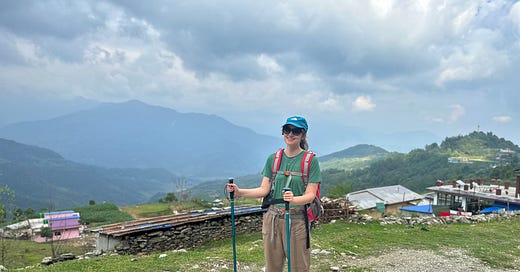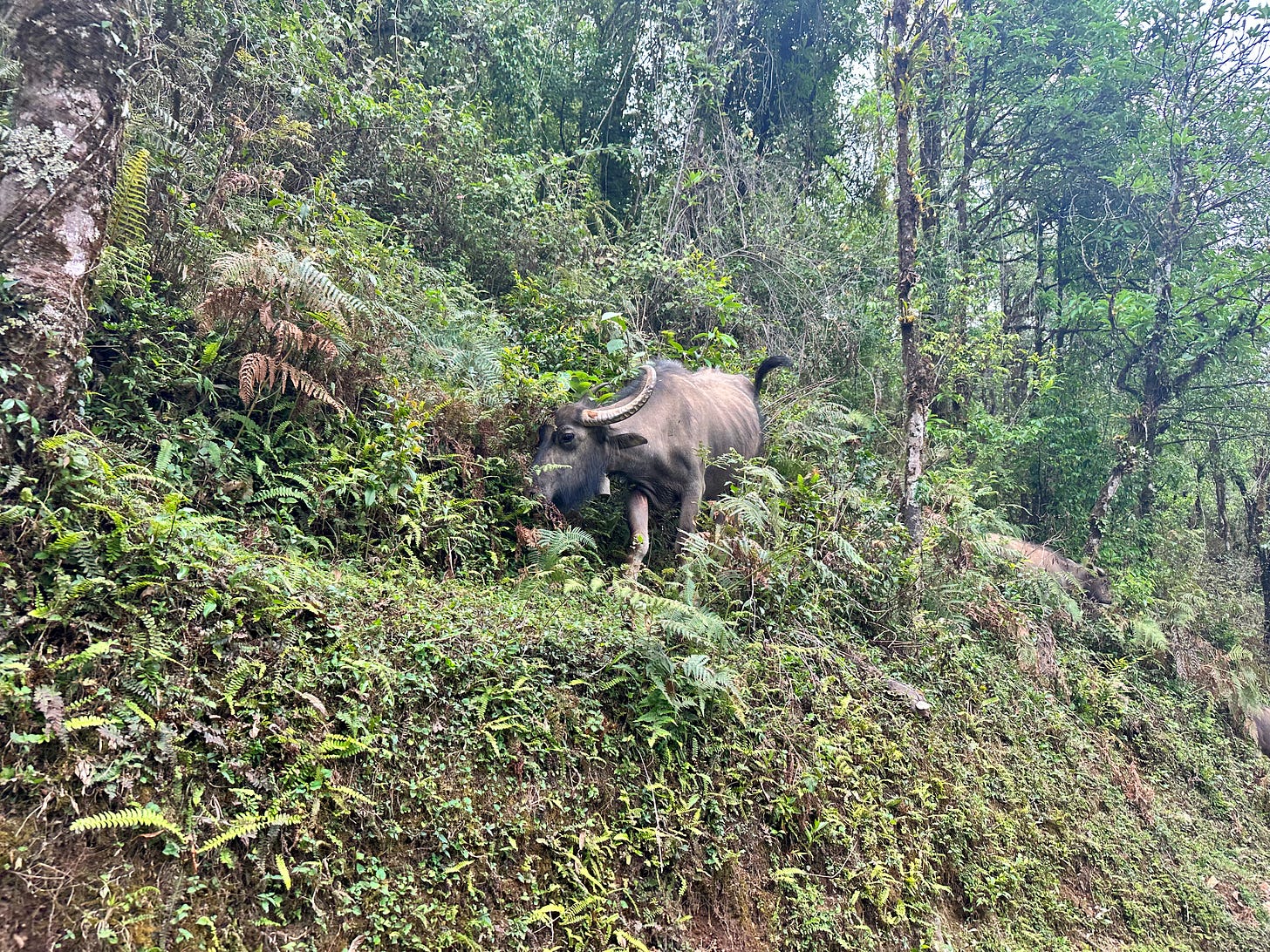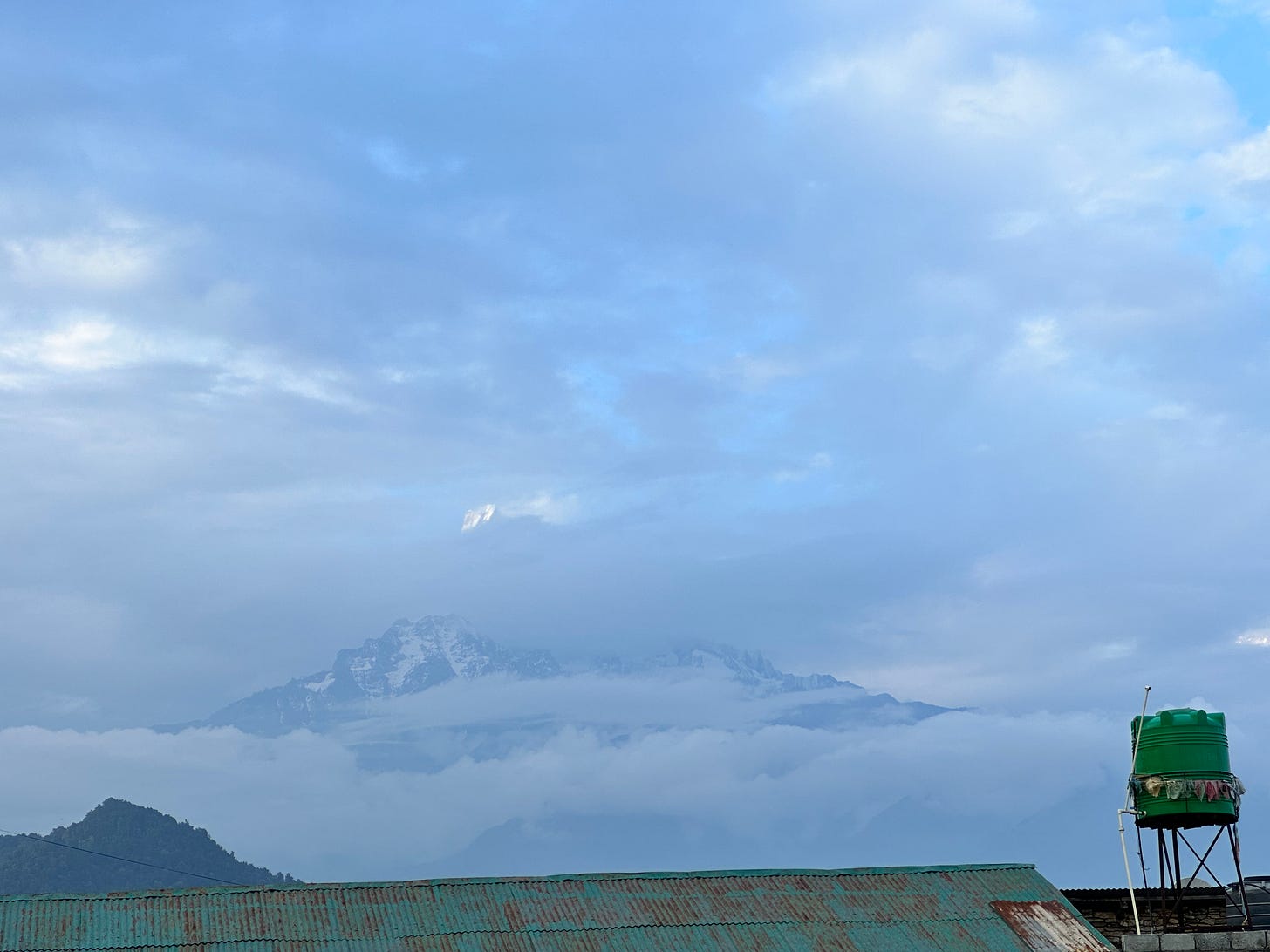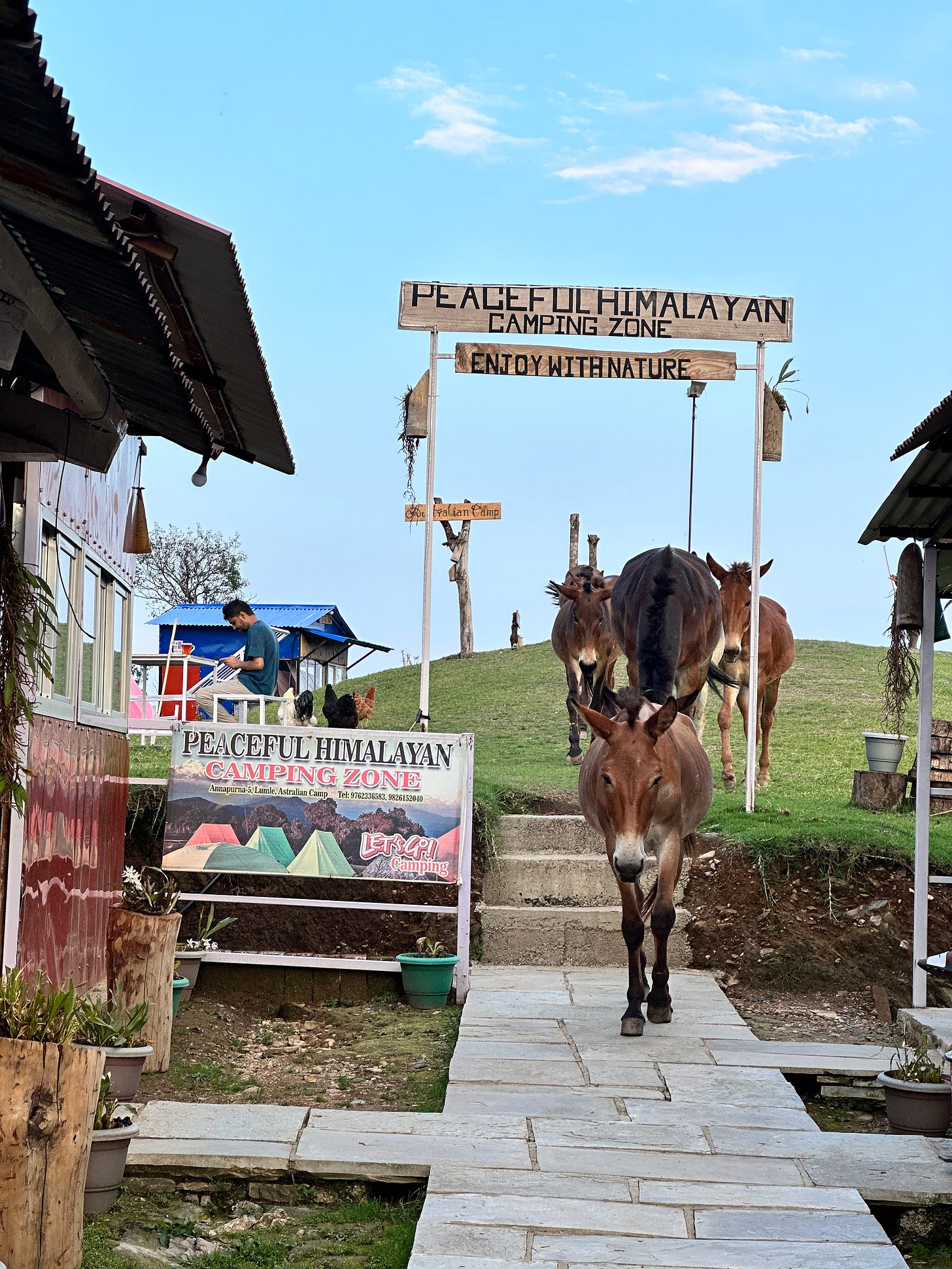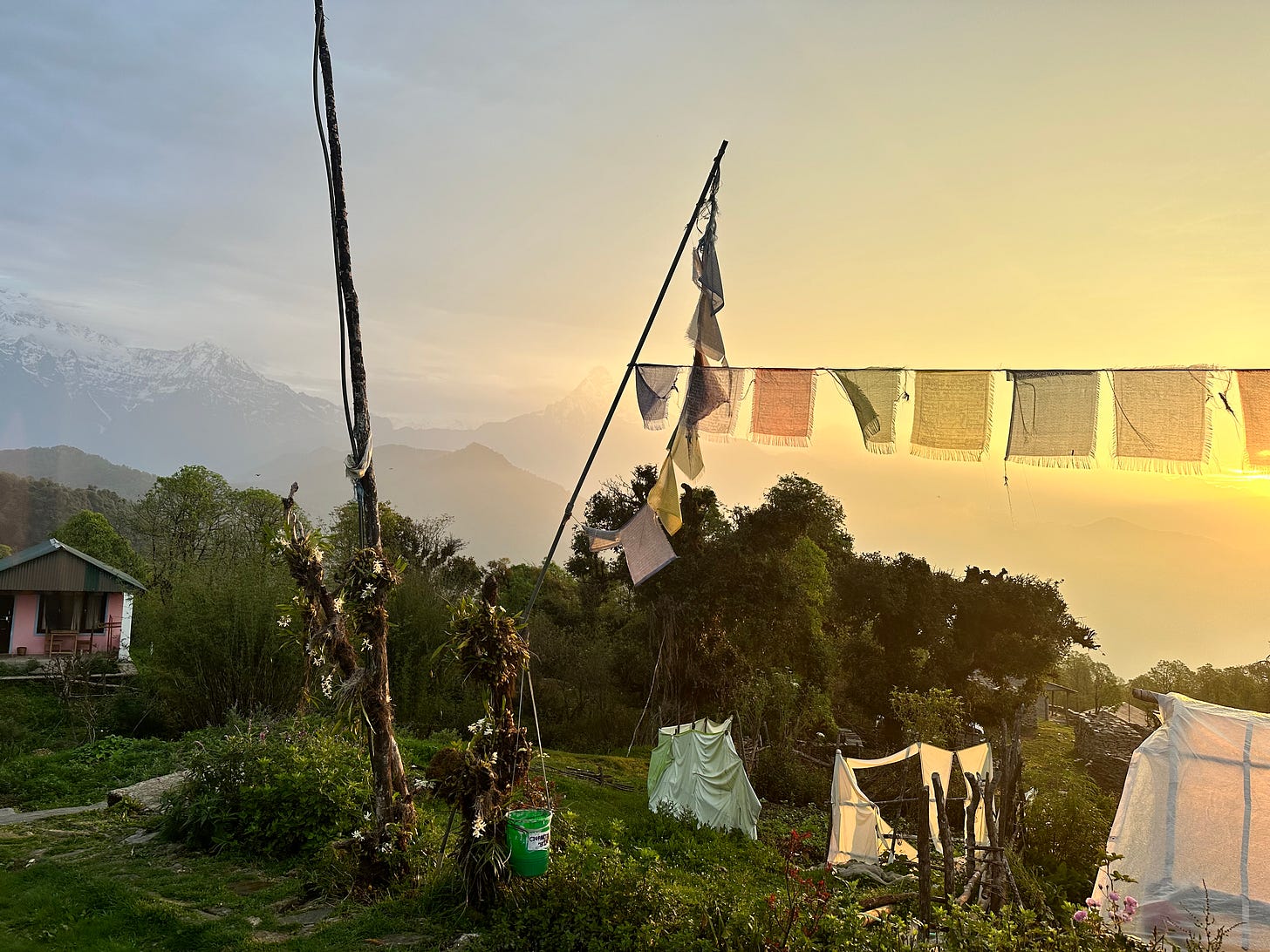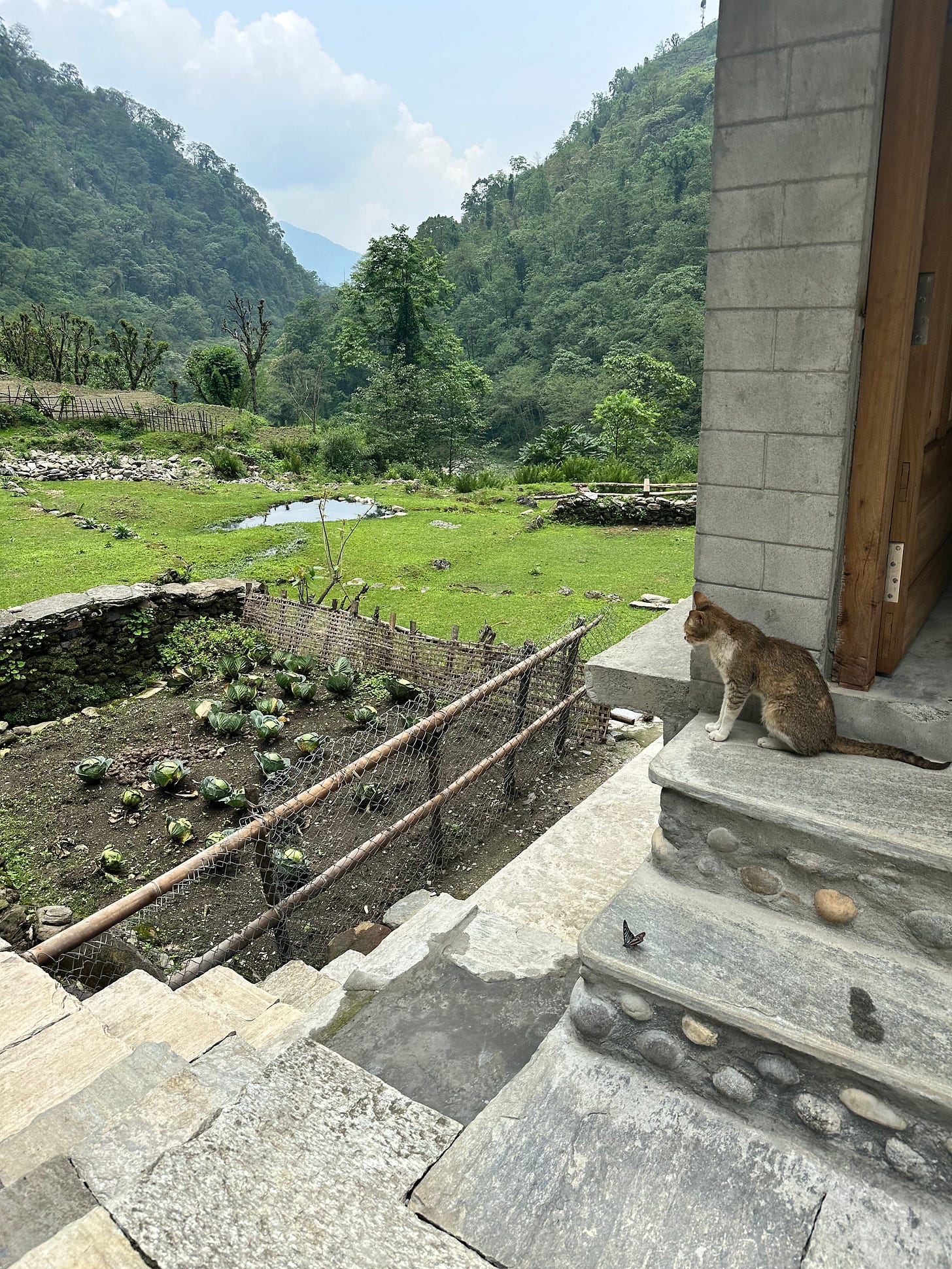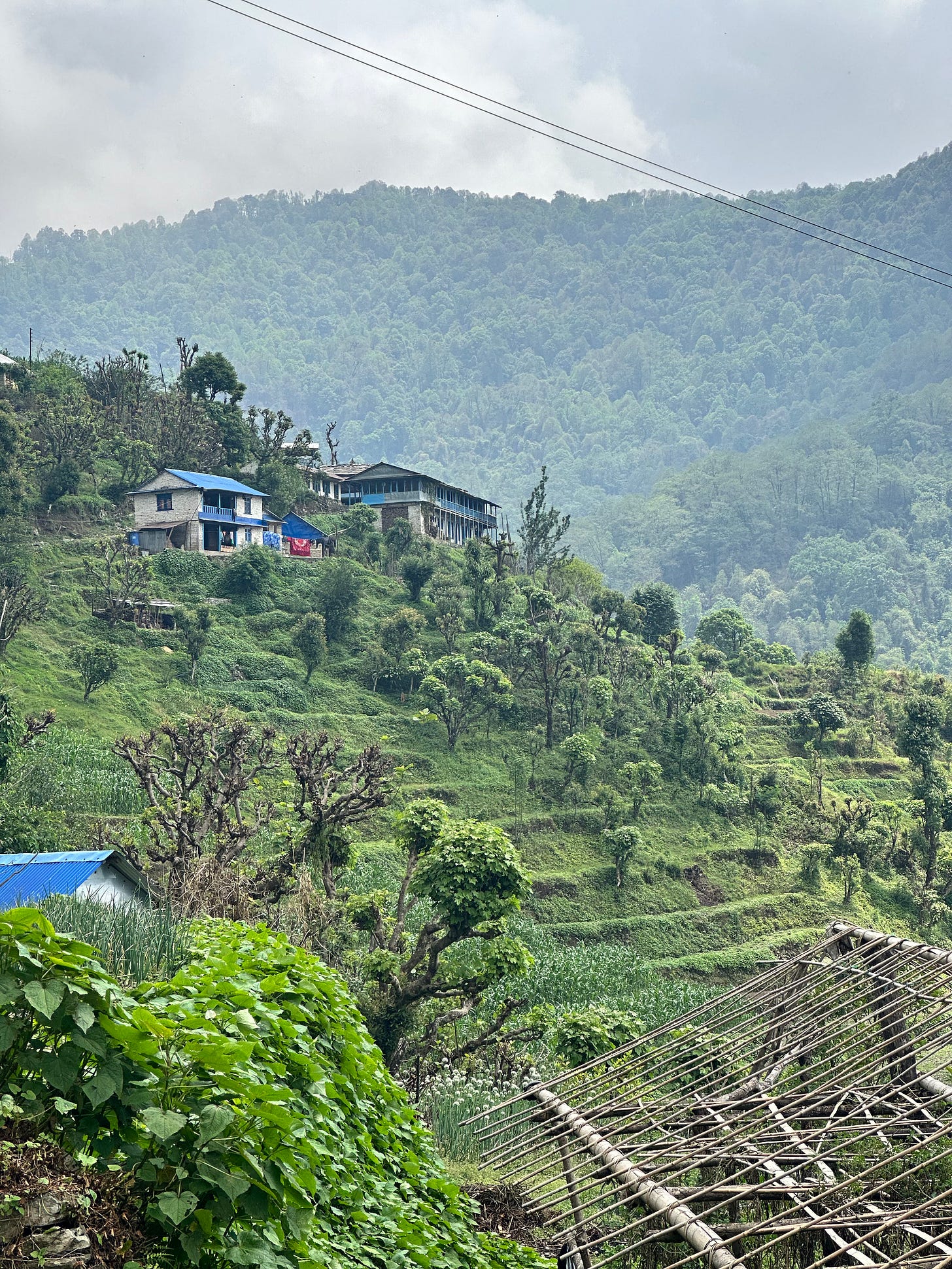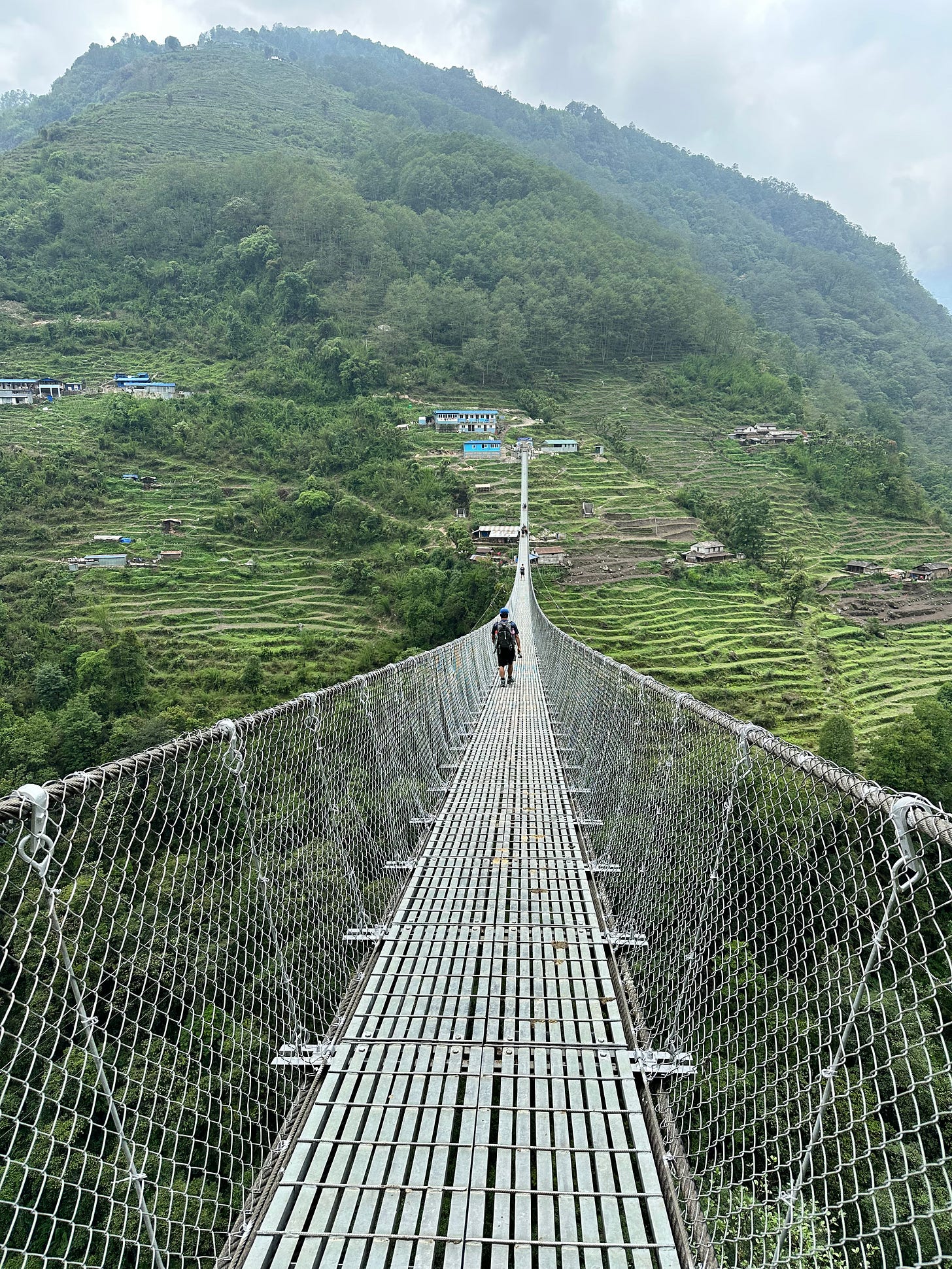I’ve spent the past month in the foothills of the Annapurna mountain range, hiking and driving through the wild slopes, exploring the rivers and streams and cities and lakes of this region. It’s been an adventure — full of ups and downs, literally and figuratively — and I’ll do my best to summarize it here.
A half hour into my trek, I didn’t think I had even half a chance of making it.
The sun was pressing down on my back, scorching my arms despite the sunscreen I’d carefully applied, soaking my shirt. My breaths came out in burning gasps as I hoisted my way up tall, steep staircases that led us into the hills we’d be climbing across for the next four days.
I’d elected to do the easiest possible multi-day trek available, mostly because I didn’t want to risk injuring myself so soon into the trip, and my long-suffering right knee does still complain when it’s strained. And thank God for that, I thought, because if this was the easiest trek, I didn’t want to know what the rest of the treks might have looked like.
We stopped every hour or so for sweets or to buy lemon-sugar water from a local home, and the people were always kind and yet curious. I could barely speak because I was so hot.
Finally, in the afternoon, we stopped for lunch at a local Nepali tea house. These sorts of tea houses line the trekking trails of the Himalayas; they’re usually family-owned and they all serve the same basic staples and offer simple lodging. I had dal bhat, my main source of nutrition during the trek. It’s a nourishing and surprisingly complex meal — I’d learn during a cooking class later — consisting of rice, potatoes, dal, and several kinds of vegetables and sauces, depending on the chef.
In the afternoon, mercifully, the sun cooled down and I found myself moving much more quickly up through ever-steeper hills. The forests grew paler and lacier, becoming less tropical and dry, and the sound of bird-calls and unidentifiable animal howls began to replace the echoes of cars and trucks and farm work.
It turned out that the heat had been my real nemesis. Buoyed by the gentle wind, I did a two hour uphill climb without stopping once. It remained relatively cool (or at least windy) for the rest of the trek thanks to the elevation, and I did much better after that.
We reached Australian Camp just after four, and I was glad to see that I had my own room; I’d been expecting shared bunks. Then I had dinner with my guide, who throughout the trek consistently persuaded me to drink more beer and eat more food than I ever would have normally. He was a funny character — I’d found him because he is my mom’s coworker’s brother — and while I did have my doubts about being alone in the woods with a man, he was professional, if a bit overzealous sometimes when it came to food and drink, throughout the whole journey.
Still, I sometimes wished I was trekking alone if only for the sake of solitude and reflection; our many meals together were sometimes full of stilted conversation. And yet there is absolutely no way I’d even have a shot at finding my own way through these mountains.
At the viewpoint on the edge of the camp, I caught my first solid glimpse of real mountains and quickly understood why Nepalis are always quick to remind travelers that the slopes we’re trekking through are actually hills, not mountains.
Fishtail Mountain’s twin peaks pierced the clouds in the distance, its slopes jagged and garnished with sheets of cruel-looking ice. I’d just read Into Thin Air by Jon Krakauer, which made me decide I will never climb a mountain, but I was glad to have his description of the monstrosity that is climbing a mountain peak ringing through my mind as we made our comparatively effortless stroll through the hills.
At night I fell asleep to the sound of Nepalis singing campfire songs, and I woke up early to watch the sun rise over the mountains. The camp was blissfully peaceful, soaked in orange light.
After breakfast, we began to walk again, and this time it felt like we were walking directly into a cloud. The forest became even lusher, thick with jewels of moisture and light, and butterflies danced across our paths as we moved further and further upwards, stopping every now and then for more tea or lemon water. Eventually the horizon disappeared completely, and all I could see was pure white beyond the palm trees.
Standing at a tea house on what felt like the top of the world, I felt a little bit of the ecstasy I’d come to the mountains searching for — just a glimpse of the elusive sense of peace and wildness that draws so many people to these peaks.
On the way down from that hill, we met up with a dog who looked remarkably like my dog Toby, with black and brown coloring and two pale dots above his eyes. (It turns out that almost every Himalayan dog looks like this). The dog proceeded to lead us on our trek for three hours, stopping to wait for us every so often. I hiked slowly, leaning heavily on my hiking poles, trying not to push my knees in any way, and the dog was patient, racing down the hills only to clamber back up. Though she was wild, I ended up petting her, and thought for a wild moment about adopting her until I decided she seemed to love these hills too much to ever leave them.
Life is simpler in many ways in these mountains; multi-generational families milk goats and raise chickens and hang their washing to dry, and there is no other civilization around for miles and miles. At one point, we stopped at one particularly idyllic guest house where a cat and a child lay beside a butterfly, all three of them watching a white horse and some buffalo grazing in front of a waterfall.
The next day it rained, our first rain of the trek. We were on the very edge of the monsoon, which was why I’d rescheduled my plans to do this trek at this time, and we were caught in a storm as we made our way to that night’s destination. But the storm made everything glitter and washed some of the dirt and sweat off of my brow. I felt, as I always feel in nature, at peace, in flow, in the presence of something holy.
In the modern world, we try desperately to control nature, to keep the elements at bay, to pretend all our technology and buildings can ever defend us from the wild reality of our inner and outer worlds. But we are nature, too, and in nature I see myself reflected in everything: the rains, the sunsets, the rush and flow of the wind, and I feel free at last.
I spent a lot of the down time on the trek reading Peter Matthiessen’s The Snow Leopard, a perfect book to read at the time because it is about the author’s own trek through the Himalayas in the 1970s. It’s also a beautiful primer on Zen Buddhism, and with koans ringing in my ears, I tried to stay in the moment as we walked, tried to chase after some of the pristine clarity that the author also searched for decades ago, like so many others who have come to these mountains, looking to find a part of themself that they had lost or perhaps always sensed but never could quite reach in the confines of ordinary reality.
That night I cozied up in the nicest tea house of our stay, which required crossing a massive suspension bridge to reach. It poured that night, the rain threatening to wash us off the mountain, but inside was a rowdy group who had just completed a trek to Annapurna Base Camp, a much longer and harder trek than mine. They even somehow persuaded me to dance with them, and their joy reminded of why people climb, in that moment, and in fact why people go searching and traveling at all.
I have been thinking a lot about the idea that perhaps we are alive at all for the same reason that we embark on travels and adventures, as difficult as they may be — because our souls, or God, or whatever is there in the true reality beyond the illusion of the individual self, simply wanted to experience the great multi-sensory adventure that is being. And what a ride it is. Still, I do wish it was just a little lighter on the suffering.
The next day we took a steep hill down to a hot spring nestled in between the hills. I immediately plunged into the warm water, and, a few moments later, my hand brushed against something on my foot. It was a gigantic leech, fat and shockingly soft. I tossed it into the bushes and continued my repose, determined not to let it mess with the mindfulness I had been cultivating for the past four days.
But back at the hotel I discovered a total of four leeches on my feet. I had not even felt their bites, but there they were, the little monsters. I threw them off the balcony and bled into the shower until my guide finally burst in with toilet paper and tissues — supplies in the guest houses, even ones as nice as this one, usually are not readily offered.
Still, I wasn’t so bothered by the leeches. As long as they weren’t about to send me back to America, I felt, I could handle it.
A bumpy Jeep ride led us back at The Mountain House, the lovely hotel I’d stayed at in Lakeside, Pokhara, and I was glad for the clean white sheets and air conditioning. After one final awkward dinner with my guide at his request, I was finally alone again.
And yet I was back in the city and surrounded by people and the chaos of Lakeside, with its million restaurants and cafes all designed for tourists. Just beyond it are streets full of real Nepalis, and the reality of Nepal: unpaved roads, wild motorbikes, stands of fruit, old women in colorful shawls sitting in the streets and kneading at baskets of grain.
I have been quite conscious of my own status as an American tourist here, quite conscious of my own privilege and how it must look to many of the Nepalis, whose world I am entering in order to escape mine, all while most of them will never have the chance to leave this country at all. Some of us have the privilege to explore the so-called simple and rustic life and to idealize it, only to go back to our hyper-modernized worlds, which we complain about so much and still elect to live in. Others, probably most people in the world, have no choice at all but to live how they were born.
I had planned on going to my next destination, a Workaway in the nearby valley, in two days, but the hosts kept delaying my arrival and so I ended up spending a full six days in Pokhara after my trek. At the start it was nice; I enjoy spending time in cafes, and I began writing a collection of essays about ecology and spirituality that I had felt inspired to work on while driving through the mountains. I do not feel qualified to speak on these topics for many reasons, but the mountains had whispered that I shouldn’t be afraid, shouldn’t wait until I’m somehow learned enough to feel confident in my own voice; because, after all, everything could end at any time.
Yet sitting in the cafes and rereading the essays, the same thoughts came out: Who are you to tell this story? And at the same time: why haven’t you told it yet?
Stories are all around. I’ve always felt like the veil between my own mind and the collective consciousness is thin. The truth is I just need to get out of my own way.
Had I known that I would have had six days I certainly would have planned another side trip, but as it was, I stayed in Pokhara and indulged in the pleasures of this designed-for-tourists pop-up city and the modern world; beautiful restaurants with views of the lake, lattes, WiFi, Bridgerton season three.
I also visited a hospital to have something I was afraid was a bite drained — a joyous way to spend an afternoon (not), but I didn’t care at all as long as it did not send me home. I’ve been trying to go on this trip for a very, very long time, after all, and it has been quite a road to get here.
Finally I was given the green light to go to the Workaway, and so only then did I leave the modern world behind once again.

